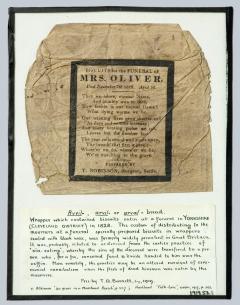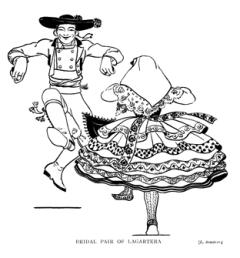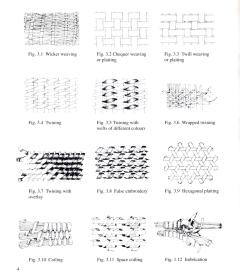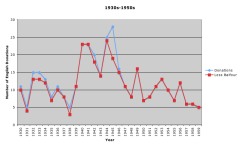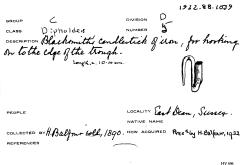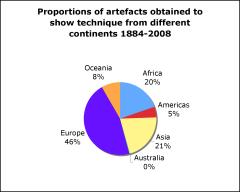ENGLAND: THE OTHER WITHIN
Analysing the English Collections at the Pitt Rivers Museum
Themed Articles
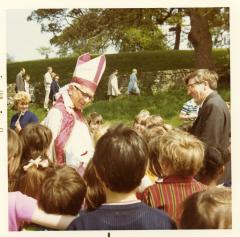
1998.464.2 Bishop Clitherow & children, Tissington well dressing, 1971. Photo: Ingegard Vallin, Donated: Ellen Ettlinger
Acquisition Events
Many of the statistics generated on the collections of the Pitt Rivers Museum are based on the total numbers of particular kinds of things.This page examines acquisition events rather than total numbers of artefacts.
Anthropological Institute in 1900
The (Royal) Anthropological Institute is the main UK based organization for all anthropologists working in the UK. This article gives more information about the members of the AI in 1900, a crucial period during its development.
Bell collection of stone tools
Alexander Montgomerie Bell's large collection of stone tools was given to the museum by his son, find out more about it on this page.
Blackwood and Otmoor
Beatrice Blackwood worked with L.H. Dudley-Buxton 'measuring the natives' on Otmoor, near Oxford in Oxfordshire. Read the History of Anthropology article on this work here.
Calendar-related artefacts
Many artefacts in the English collections of the Pitt Rivers Museum are related to calendar events, or are time-specific. Most of these artefacts reflect, to a greater or lesser effect, the effects of the Christian calendar and traditional annual Christian activities.
Estella Louisa Michaela Canziani (1887-1964)
Estella Canziani was an artist, writer, keen folklorist and donor of major collections to the Pitt Rivers Museum (and Birmingham City Museum and Art Gallery). These pages explore her contributions to the Museum and to the anthropological and folkloric debates of the mid-twentieth century.
Characterising five 'named' counties
As part of the original submission to the funding body for the project (the ESRC), the project team identified certain key counties whose artefacts were well-represented in the collections. This page considers the particular characteristics of each county by reviewing the statistics generated about it.
Death-related artefacts
This themed object biography is a general discussion about death-related artefacts and details about the Museum's holdings of such objects. It includes funeral accessories and food, mourning clothes , jewellery and accessories, and memorial items.
Documentation at the Pitt Rivers Museum
The Pitt Rivers Museum has always documented its collections and prided itself that it has some of the best documentation for its collections of any museum in the UK. Information about documentation is given, collated from the Museum's Annual Reports.
English folklorists
The Folklore Society first began in 1878, many of its members contributed to thoughts of what defined 'englishness' and also contributed artefacts to the Pitt Rivers Museum. These pages look at a selection of such people.
Ellen Ettlinger (1902-1994) - folklorist and English photographic collections donor
Ellen Ettlinger was keenly interested in the folklore of the British Isles. In 1965 she donated images of English churches, houses and peculiar customs to the Pitt Rivers Museum. This section will explore this collection and her work. You can find out more about the individual images by searching the photographic database for her name in the PRM Source field.
Ethnology, Ethnography, Archaeology, Anthropology and Folklore
Discussion of what individuals connected with the Pitt Rivers Museum, University of Oxford, believed these disciplines to involve and what links there were between them.
Finding the Key: The Parsons Collection
Exploring the reasons why a collection of over a thousand locks and keys, including 828 from England, were donated to the Pitt Rivers Museum by a Cambridgeshire local historian and folklorist.
London gunmakers
Guns produced by many London gunmakers are in the Pitt Rivers collections, this page gives more information about them.
Pitt Rivers Museum and a Museum for England
Several members of the museum's staff were involved in suggestions and discussions of the need for a Museum for English or British Ethnography ...
Oxfordshire collections
The Pitt Rivers Museum is in Oxfordshire and curators have accessioned many objects from the surrounding city and countryside into its collections. This section examines the social history collections from Oxfordshire held by the PRM, Oxfordshire County Museum Services and Ashmolean Museum.
Pitt Rivers' and archaeology in England
Augustus Henry Lane Fox Pitt Rivers donated the founding collection of the Museum to the University of Oxford in 1884. This included a large number of archaeological artefacts obtained from his excavations in England. These webpages examine these excavations in detail and the objects found in them.
Purchase of English objects for the Museum
Not all objects are equal, some are chosen and some are just passively accepted from donors. This site looks at some of the 'chosen' artefacts in the English collections, those that were purchased by Augustus Henry Lane Fox Pitt Rivers for the founding collection and those purchased by museum staff to add to the Pitt Rivers Museum's English collections.
Scrimshaw collections at the Museum
Scrimshaw are the ivory and bone carvings of sailors, particularly those involved in the whaling industry in the nineteenth century. Find out more about the artefacts and the people who collected them and donated them.
Teaching at the Pitt Rivers Museum
The Pitt Rivers Museum is an University Museum, which has taught students since 1893. Information about each year's teaching activity is given, collated from the Museum's Annual Reports.
The study of technologies and materials at the Museum
Staff throughout the Museum's history have been particularly interested in the ways different technologies and materials affect artefacts and the way they are made. This section of the website relates all the different ways that museum staff (and Pitt Rivers) have looked at technologies and material.
